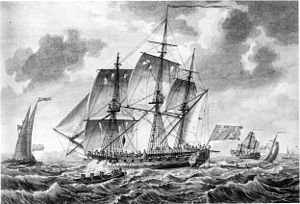HMS Winchelsea (1764)
 The HMS Alarm, a sister ship of HMS Winchelsea, in 1758
| |
| History | |
|---|---|
| Name | HMS Winchelsea |
| Ordered | 11 August 1761 |
| Builder | Sheerness Dockyard |
| Laid down | 29 March 1762 |
| Launched | 31 May 1764 |
| Commissioned | February 1769 |
| Honours and awards | Naval General Service Medal with clasp "Egypt"[1] |
| Fate | Sold to be broken up November 1814 |
| General characteristics | |
| Class and type | Niger-class fifth-rate frigate |
| Tons burthen | 679.7 bm |
| Length | 125 ft (38 m) |
| Beam | 35 ft 2 in (10.72 m) |
| Depth of hold | 12 ft (3.7 m) |
| Sail plan | Full-rigged ship |
| Complement | 220 |
| Armament | |
HMS Winchelsea was a 32-gun fifth-rate Niger-class frigate of the Royal Navy, and was the sixth Royal Navy ship to bear this name (or its archaic form Winchelsey). She was ordered during the Seven Years' War, but completed too late for that conflict. She cost £11,515-18-0d to build.
Career
HMS Winchelsea was brought into service in February 1769, under Captain Samuel Goodall and sailed for service to the Mediterranean.[2] In December 1769 she struck rocks off Cádiz, Spain and was severely damaged. Refloated, she was taken in to Gibraltar for repairs.[3] Command was passed to Captain Thomas Wilkinson in June 1771 with the ship remaining at her Mediterranean station.[2]
In June 1775 she was paid off and returned to Sheerness Dockyard to be placed in ordinary.[2]
She saw later service during the American War of Independence. In December, 1776, under command of N. Bateman, she captured brig "Fraiture". Between late December, 1776 and early March, 1777 she captured schooners "Sally" and "St. Ann". On 14 May, 1777 she captured brigantine "Anne". On 19 May she captured sloop "Lamulant". On 18 August, 1777 she captured Polacra "La Providance". She captured sloops "Esprence" and "Elizabeth", brig "L'Creetia", probably between 12 September and 18 October, 1777. She captured sloop "Lidia" in early November, 1777. She captured schooner "Dorothy" 18 November, 1777. She captured "St. Joseph" between 18 November and 7 December, 1777. She captured sloop "Betsy" between 7-9 December, 1777. She captured sloops "Revenge", "Catherine", and schooner "Oxford" probably between 5-12 January, 1778. She captured schooner "Betsy" and sloop "Victory" probably in late January, 1778.[4] On 31 May 1778 she captured an unknown sloop, and possibly privateer "Rose", 27 leagues south of Cape Hatteras.[5] Served until 1794, and was refitted as a troop ship at Portsmouth Dockyard in 1799–1800.[2] Because Winchelsea served in the Navy's Egyptian campaign (8 March to 2 September 1801), her officers and crew qualified for the clasp "Egypt" to the Naval General Service Medal that the Admiralty authorised in 1850 for all surviving claimants.[Note 1]
Fate
She became a convalescent ship at Sheerness in 1803, finally being sold there to be broken up in November 1814.
Notes
Citations
- ^ "No. 21077". The London Gazette. 15 March 1850. pp. 791–792.
- ^ a b c d Winfield 2007, pp. 197-98
- ^ "(untitled)". Lloyd's List (3544). 16 January 1770.
- ^ "Naval Documents of The American Revolution Volume 11 European THEATRE: Jan. 1, 1778–Mar. 31, 1778 American: Jan. 1, 1778–Mar. 31, 1778" (PDF). U.S. Government printing office via Imbiblio. Retrieved 14 November 2023.
- ^ "NAVAL DOCUMENTS OF The American Revolution" (PDF). history.navy.mil. Retrieved 7 November 2021.
- ^ "No. 17915". The London Gazette. 3 April 1823. p. 633.
References
- Colledge, J. J.; Warlow, Ben (2006) [1969]. Ships of the Royal Navy: The Complete Record of all Fighting Ships of the Royal Navy (Rev. ed.). London: Chatham Publishing. ISBN 978-1-86176-281-8.
- Lavery, Brian (2003) The Ship of the Line – Volume 1: The development of the battlefleet 1650–1850. Conway Maritime Press. ISBN 0-85177-252-8.
- Winfield, Rif (2007) British Warships in the Age of Sail, 1714-1792. Seaforth Publishing. ISBN 978-1-84415-700-6.
